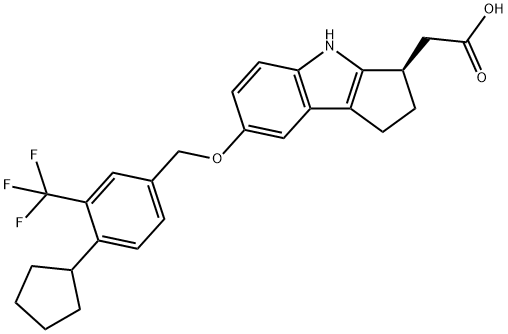- Etrasimod
-

- $48.00 / 1mg
-
2025-09-29
- CAS:1206123-37-6
- Min. Order:
- Purity: 98.52%
- Supply Ability: 10g
- Etrasimod
-

- $5.00/ KG
-
2025-09-26
- CAS:1206123-37-6
- Min. Order: 1KG
- Purity: 99% hplc
- Supply Ability: 500TONS
- Etrasimod
-

- $100.00 / 1KG
-
2022-02-25
- CAS:1206123-37-6
- Min. Order: 1KG
- Purity: 98%
- Supply Ability: 100KG
|
| | Etrasimod Basic information |
| Product Name: | Etrasimod | | Synonyms: | Etrasimod;APD334;Neflamapimod;(R)-2-(7-(4-cyclopentyl-3-(trifluoromethyl)benzyloxy)-1,2,3,4-tetrahydrocyclopenta[b]indol-3-yl)acetic acid;APD-334;APD 334;CS-2445;Etrasimod(APD334);APD334; APD-334; APD 334; ETRASIMOD | | CAS: | 1206123-37-6 | | MF: | C26H26F3NO3 | | MW: | 457.48 | | EINECS: | | | Product Categories: | APIS | | Mol File: | 1206123-37-6.mol |  |
| | Etrasimod Chemical Properties |
| Boiling point | 621.4±50.0 °C(Predicted) | | density | 1.326±0.06 g/cm3(Predicted) | | storage temp. | Store at -20°C | | solubility | DMSO:29.0(Max Conc. mg/mL);63.39(Max Conc. mM)
DMSO:PBS (pH 7.2) (1:1):0.5(Max Conc. mg/mL);1.09(Max Conc. mM)
DMF:30.0(Max Conc. mg/mL);65.57(Max Conc. mM)
Ethanol:12.5(Max Conc. mg/mL);27.32(Max Conc. mM) | | form | A crystalline solid | | pka | 4.61±0.10(Predicted) | | color | White to khaki | | InChIKey | MVGWUTBTXDYMND-QGZVFWFLSA-N | | SMILES | N1C2=C(C=C(OCC3=CC=C(C4CCCC4)C(C(F)(F)F)=C3)C=C2)C2CC[C@H](CC(O)=O)C1=2 |
| | Etrasimod Usage And Synthesis |
| Uses | Etrasimod (APD334) is a potent, selective and orally available antagonist of the sphingosine-1-phosphate-1 (S1P1) receptor with an IC50 value of 1.88 nM in CHO cells. | | Synthesis | Method 1 (α) - Preparation of (R)-2-(7-((4-cyclopentyl-3-(trifluoromethyl)benzyl)oxy)-1,2,3,4-tetrahydrocyclopenta[b]indol-3-yl)acetic acid (compound (1a) of formula (I)) and its L-arginine salt.
Step A: (i) Preparation of (R)-2-(7-((4-cyclopentyl-3-(trifluoromethyl)benzyl)oxy)-1,2,3,4-tetrahydrocyclopentadieno[b]indol-3-yl)acetic acid. In a 500 mL three-necked round-bottomed flask (equipped with a magnetic stir bar, N2 inlet, thermocouple, and condenser), racemic 2-(7-((4-cyclopentyl-3-(trifluoromethyl)benzyl)oxy)-1,2,3,4-tetrahydrocyclopentadieno[b]indol-3-yl)ethyl acetate (20.00 g, 41.19 mmol) was dissolved in acetonitrile (185 mL), and added to the potassium phosphate buffer (15 mL, 1.0 M, pH=7.80), followed by the addition of immobilized recombinant Antarctic pseudohyphae lipase B (1.0 g, 5865 U/g, 5865 U). The resulting yellow suspension was stirred under N2 protection at approximately 40 °C for 16 hours. Upon completion of the reaction, the pH of the mixture was adjusted to 3.96 with 1 M citric acid and subsequently filtered through a Whatman filter cup. The solids were washed with acetonitrile (3 x 15 mL). The filtrate and washings were combined and concentrated under vacuum at about 30 °C to give an orange colored residue. The residue was partitioned between ethyl acetate (60 mL) and brine (60 mL). The layers were separated and the aqueous layer was extracted with ethyl acetate (2 x 40 mL). The organic layers were combined, washed sequentially with water (2 x 80 mL) and brine (2 x 80 mL), dried with Na2SO4, decanted, and concentrated under vacuum at 30 °C to give an orange colored oil. The oily material was dried in vacuum at room temperature overnight to give a light orange oil (22.203 g) containing (R)-2-(7-((4-cyclopentyl-3-(trifluoromethyl)benzyl)oxy)-1,2,3,4-tetrahydrocyclopentadieno[b]indol-3-yl)acetic acid. The crude product was determined to be 41.41 wt% (9.194 g) with an ee value of 99.42%. | | in vivo | APD334 has a relatively low systemic clearance (<4% of hepatic blood flow) and high Cmax across all species. In both dog and monkey a significant decrease in volume of distribution (Vss) is observed relative to rodent. Oral bioavailability is in the range of 40–100%, and the terminal phase half-life varied from 6 h in monkey, to as long as 29 h in dog. Rat and monkey t1/2 values for siponimod (another S1P1 modulator currently in human trials) have been disclosed and are 6 and 19 h, respectively[1]. | | References | [1] Buzard DJ, et al. Discovery of APD334: Design of a Clinical Stage Functional Antagonist of the Sphingosine-1-phosphate-1 Receptor. ACS Med Chem Lett. 2014 Nov 4;5(12):1313-7. DOI:10.1021/ml500389m |
| | Etrasimod Preparation Products And Raw materials |
|